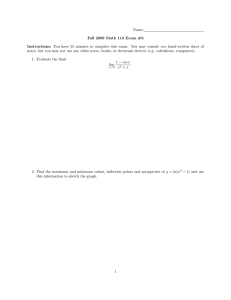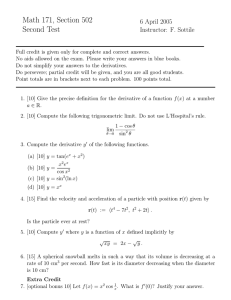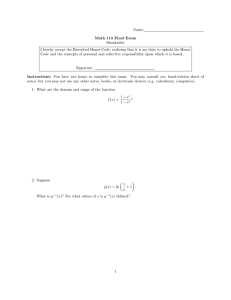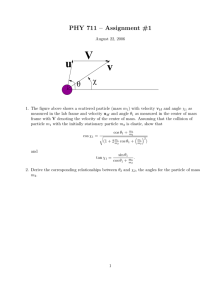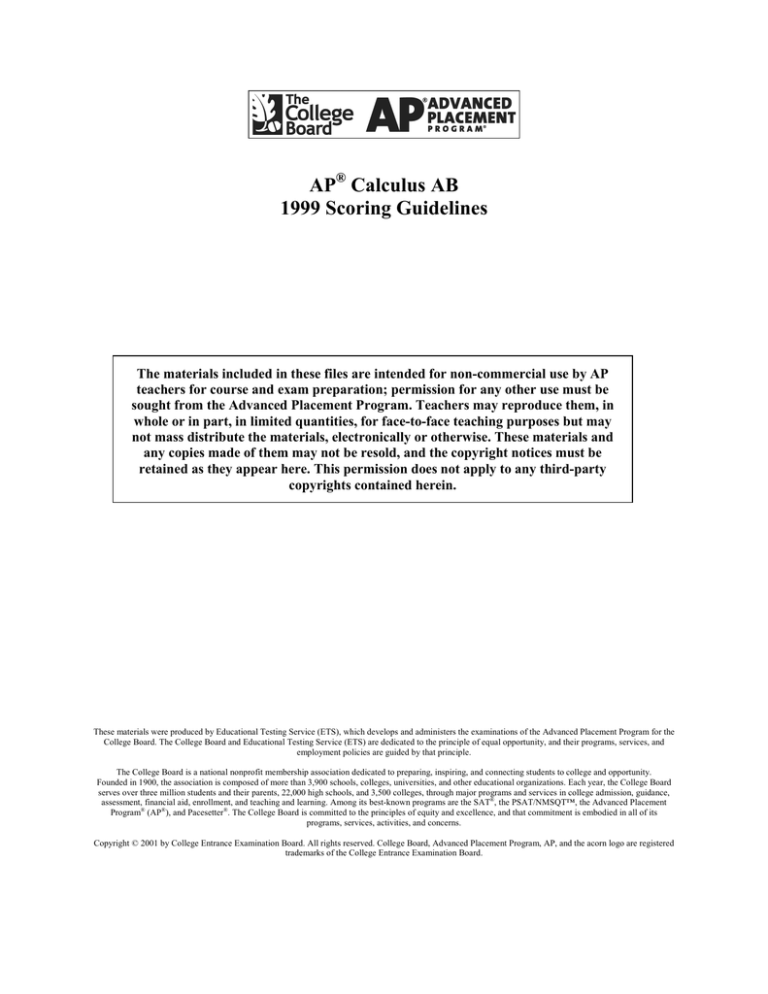
AP® Calculus AB
1999 Scoring Guidelines
The materials included in these files are intended for non-commercial use by AP
teachers for course and exam preparation; permission for any other use must be
sought from the Advanced Placement Program. Teachers may reproduce them, in
whole or in part, in limited quantities, for face-to-face teaching purposes but may
not mass distribute the materials, electronically or otherwise. These materials and
any copies made of them may not be resold, and the copyright notices must be
retained as they appear here. This permission does not apply to any third-party
copyrights contained herein.
These materials were produced by Educational Testing Service (ETS), which develops and administers the examinations of the Advanced Placement Program for the
College Board. The College Board and Educational Testing Service (ETS) are dedicated to the principle of equal opportunity, and their programs, services, and
employment policies are guided by that principle.
The College Board is a national nonprofit membership association dedicated to preparing, inspiring, and connecting students to college and opportunity.
Founded in 1900, the association is composed of more than 3,900 schools, colleges, universities, and other educational organizations. Each year, the College Board
serves over three million students and their parents, 22,000 high schools, and 3,500 colleges, through major programs and services in college admission, guidance,
assessment, financial aid, enrollment, and teaching and learning. Among its best-known programs are the SAT®, the PSAT/NMSQT™, the Advanced Placement
Program® (AP®), and Pacesetter®. The College Board is committed to the principles of equity and excellence, and that commitment is embodied in all of its
programs, services, activities, and concerns.
Copyright © 2001 by College Entrance Examination Board. All rights reserved. College Board, Advanced Placement Program, AP, and the acorn logo are registered
trademarks of the College Entrance Examination Board.
AB{1
1999
1. A particle moves along the y{axis with velocity given by v(t) = t sin( ) for t 0.
(a) In which direction (up or down) is the particle moving at time t = 1:5? Why?
(b) Find the acceleration of the particle at time t = 1:5. Is the velocity of the particle increasing at
t = 1:5? Why or why not?
(c) Given that y(t) is the position of the particle at time t and that y(0) = 3, nd y(2).
(d) Find the total distance traveled by the particle from t = 0 to t = 2.
t2
(a) v(1:5) = 1:5 sin(1:52) = 1:167
Up, because v(1:5) > 0
1: answer and reason
(b) a(t) = v (t) = sin t2 + 2t2 cos t2
a(1:5) = v (1:5) = ;2:048 or ;2:049
No; v is decreasing at 1.5 because v (1:5) < 0
0
0
2
( 1: a(1:5)
1: conclusion and reason
0
(c) y(t) =
=
Z
Z
v (t) dt
t sin t2 dt = ;
cos t2 + C
2
1 + C =) C = 7
2
2
1
7
y (t) = ; cos t2 +
2
2
1
7
y (2) = ; cos 4 + = 3:826 or 3:827
2
2
y (0) = 3 = ;
(d) distance =
Z2
0
jv(t)j dt = 1:173
or
v (t) = t sin t2 = 0
p
t = 0 or t = 1:772
p
y (0) = 3 ; y ( ) = 4 ; y (2) = 3:826 or 3:827
p
p
[y( ) ; y(0)] + [y( ) ; y(2)]
= 1:173 or 1:174
Z
8
>
1:
y
(
t
)
=
v (t) dt
>
>
<
3 1: y (t) = ; 1 cos t2 + C
>
2
>
>
: 1: y(2)
8 1: limits of 0 and 2 on an integral of
>
>
v (t) or jv (t)j
>
>
>
or
>
>
< uses y(0) and y(2) to compute distance
3
> 1: handles change of direction at student's
>
>
turning point
>
>
>
: 1: answer
0/1 if incorrect turning point
AB{2 / BC{2
1999
2. The shaded region, R, is bounded by the graph of y = x2 and the line
y = 4, as shown in the gure above.
(a) Find the area of R.
(b) Find the volume of the solid generated by revolving R about the
x{axis.
(c) There exists a number k, k > 4, such that when R is revolved about
the line y = k, the resulting solid has the same volume as the solid in
part (b). Write, but do not solve, an equation involving an integral
expression that can be used to nd the value of k.
(a) Area =
Z 2
;2
=2
(
(4 ; x2 ) dx
Z 2
0
2
(4 ; x2 ) dx
x3
= 2 4x ; 3
1: integral
1: answer
2
0
= 32
3 = 10:666 or 10:667
(b) Volume = Z 2
= 2
;2
Z 2
0
42 ; (x2 )2 dx
(16 ; x4 ) dx
8
>
>
<
1: limits and constant
3 1: integrand
>
>
:
1: answer
5 2
= 2 16x ; x5
0
= 256
5 = 160:849 or 160:850
(c) Z 2
;2
(k ; x2 )2 ; (k ; 4)2 dx = 256
5
8
>
>
>
>
<
1: limits and constant
2: integrand
4
< ;1 > each error
>
>
>
>
:
1: equation
y
y
x2
y
O
4
x
AB{3 / BC{3
1999
3. The rate at which water ows out of a pipe, in gallons per hour, is
given by a dierentiable function of time . The table above
shows the rate as measured every 3 hours for a 24{hour period.
(a) Use a midpoint Riemann
sum with 4 subdivisions of equal
Z 24
length to approximate
( ) . Using correct units, explain
0
the meaning of your answer in terms of water ow.
(b) Is there some time , 0
24, such that ( ) = 0? Justify
your answer.
(c) The rate of water ow ( ) can be approximated by
1 ;768 + 23 ; 2 . Use ( ) to approximate the
( ) = 79
average rate of water ow during the 24{hour time period.
Indicate units of measure.
R
R t
t
()
(hours) (gallons per hour)
0
9.6
3
10.4
10.8
6
9
11.2
11.4
12
15
11.3
10.7
18
21
10.2
24
9.6
t
t
dt
< t <
R
0
t
R t
t
Q t
(a)
Z 24
0
()
R t
dt
t
Q t
6[ (3) + (9) + (15) + (21)]
R
R
R
R
= 6[10 4 + 11 2 + 11 3 + 10 2]
= 258.6 gallons
This is an approximation to the total ow in
gallons of water from the pipe in the 24{hour
period.
:
:
:
:
(b) Yes;
Since (0) = (24) = 9 6, the Mean Value
Theorem guarantees that there is a , 0
24,
such that ( ) = 0.
R
R
:
t
R
0
(
2
R
R
R
1: answer
1: MVT or equivalent
< t <
8
1:
>
>
<
Q t
Z 24
0
(3) + (9) + (15) + (21)
3 1: answer
>
>
:
1: explanation
R
t
(c) Average rate of ow
average value of ( )
1
= 24
8
1:
>
>
<
R t
limits and average value constant
3 1: ( ) as integrand
>
>
:
1: answer
Q t
1 (768 + 23 ; 2 )
79
t
t
dt
= 10 785 gal/hr or 10.784 gal/hr
:
(units) Gallons in part (a) and gallons/hr in
part (c), or equivalent.
1: units
AB{4
1999
4. Suppose that the function f has a continuous second derivative for all x, and that f (0) = 2, f 0 (0) = ;3,
and f 00 (0) = 0. Let g be a function whose derivative is given by g0 (x) = e;2x(3f (x) + 2f 0(x)) for all x.
(a) Write an equation of the line tangent to the graph of f at the point where x = 0.
(b) Is there sucient information to determine whether or not the graph of f has a point of inection
when x = 0? Explain your answer.
(c) Given that g(0) = 4, write an equation of the line tangent to the graph of g at the point where
x = 0.
(d) Show that g00 (x) = e;2x(;6f (x) ; f 0 (x) + 2f 00 (x)). Does g have a local maximum at x = 0? Justify
your answer.
(a) Slope at x = 0 is f 0 (0) = ;3
At x = 0, y = 2
y ; 2 = ;3(x ; 0)
(b) No. Whether f 00 (x) changes sign at x = 0 is
unknown. The only given value of f 00 (x) is
f 00 (0) = 0.
(c) g0 (x) = e;2x (3f (x) + 2f 0(x))
g0 (0) =
e
0
(3f (0) + 2f 0(0))
1: equation
2
2
( 1: answer
1: explanation
( 1: g0(0)
1: equation
= 3(2) + 2(;3) = 0
y ; 4 = 0(x ; 0)
y=4
(d) g0 (x) = e;2x (3f (x) + 2f 0(x))
g00 (x) = (;2e;2x)(3f (x) + 2f 0(x))
+ e;2x (3f 0(x) + 2f 00(x))
= e;2x(;6f (x) ; f 0 (x) + 2f 00 (x))
g00 (0) = e0 [(;6)(2) ; (;3) + 2(0)] = ;9
Since g0 (0) = 0 and g00 (0) < 0, g does have a
local maximum at x = 0.
8
2: verify derivative
>
>
product or chain rule error
>
< 0/2
<;
1
> algebra errors
4
>
1: g0 (0) = 0 and g00 (0)
>
>
: 1: answer and reasoning
AB{5 / BC{5
1999
5. The graph of the functionZ x, consisting of three line segments, is
given above. Let ( ) =
() .
1
(a) Compute (4) and (;2).
(b) Find the instantaneous rate of change of , with respect to , at
= 1.
(c) Find the absolute minimum value of on the closed interval
[;2 4]. Justify your answer.
(d) The second derivative of is not dened at = 1 and = 2.
How many of these values are {coordinates of points of
inection of the graph of ? Justify your answer.
f
g x
f t
g
dt
4
3
g
g
2
1
x
x
g
–2 –1 O
–1
;
g
x
(1, 4)
(2, 1)
1 2
3
4
(4, –1)
–2
x
x
g
(a) (4) =
Z4
g
g
1
(;2) =
(
( ) = 32 + 1 + 12 ; 12 = 25
f t dt
Z ;2
( ) = ; 12 (12) = ;6
f t
1
2
(c)
g
1: answer
f
is increasing on [;2 3] and decreasing on [3 4].
Therefore, has absolute minimum at an
endpoint of [;2 4].
Since (;2) = ;6 and (4) = 25 ,
the absolute minimum value is ;6.
g
;
;
g
;
g
8
>
< 1: interior analysis
3 1: endpoint analysis
>
: 1: answer
g
(d) One; = 1
On (;2 1), 00 ( ) = 0 ( ) 0
On (1 2), 00 ( ) = 0 ( ) 0
On (2 4), 00 ( ) = 0 ( ) 0
x
;
g
x
f
x
>
;
g
x
f
x
<
;
g
x
f
x
<
Therefore (1 (1)) is a point of inection and
(2 (2)) is not.
;g
;g
g
dt
(b) 0 (1) = (1) = 4
g
1: (4)
1: (;2)
8
>
< 1: choice of = 1 only
3 1: show (1 (1)) is a point of inection
>
: 1: show (2 (2)) is not a point of inection
x
;g
;g
AB{6
6. In the gure above, line ` is tangent to the graph of y = x12
1
, where w > 0. Point
at point P , with coordinates w;
1999
y
y = 12
x
w2
P
Q has coordinates (w; 0). Line ` crosses the x{axis at the
point R, with coordinates (k; 0).
x
(a) Find the value of k when w = 3.
O
Q
R
(b) For all w > 0, nd k in terms of w.
(c) Suppose that w is increasing at the constant rate of 7 units per second. When w = 5, what is the
rate of change of k with respect to time?
(d) Suppose that w is increasing at the constant rate of 7 units per second. When w = 5, what is the
rate of change of the area of 4PQR with respect to time? Determine whether the area is increasing
or decreasing at this instant.
(a)
dy = ; 2 ; dy = ; 2
dx
x3 dx x=3
27
2
2.
Line ` through 3; 91 and (k; 0) has slope ; 27
0 ; 91
2 or 0 ; 1 = ; 2 (k ; 3)
Therefore, k ; 3 = ; 27
9
27
k = 92
(b)
Line ` through w; w12 and (k; 0) has slope ; w23 .
0 ; w12
Therefore, k ; w = ; w23 or 0 ; w12 = ; w23 (k ; w)
8
>
< 1:
>
:
dy dx x=3
1: answer
8
>
< 1:
equation relating w and k,
using slopes
2
>
:
1: answer
k = 23 w
(c)
(d)
dk = 3 dw = 3 7 = 21 ;
dt 2 dt 2
2
;
.........P........w; 1=w2
dk = 21
dt w=5 2
... ..........
..........
...
........
...
................................................. R(k; 0)
Q(w; 0)
A = 12 (k ; w) w12 = 21 32 w ; w w12 = 41w
dA = ; 1 dw
dt
4w2 dt
dA = ; 1 7 = ;0:07
dt w=5
100
Therefore, area is decreasing.
1: answer using
8
1:
>
>
>
>
>
>
>
>
>
1:
>
>
<
dw = 7
dt
area in terms of w and/or k
dA implicitly
dt
4
>
dA using dw = 7
>
>
1:
>
>
>
dt w=5
dt
>
>
>
>
>
:
1: conclusion
Note: 0/4 if A constant



